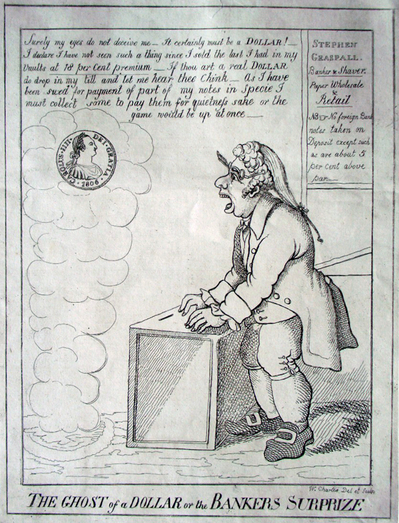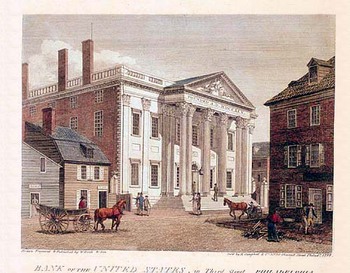Graphic Arts Collection GA 2013- in process
At the beginning of the nineteenth century, the First Bank of the United States stood on South Third Street in Philadelphia. Just down the block, Scottish-born artist William Charles (1776-1820) opened his first American print shop, publishing etchings, illustrated books, and caricatures. Over by the river on North Water Street, the shipping magnate and financier Stephen Girard (1750-1831) operated his trading business and made more money than anyone else in the United States.
When the charter for the First Bank expired in 1811, Girard bought the building and most of its stock, opening his own bank in its place. Charles watched as Girard’s fortune grew and eventually, published a caricature of the banker.
In the print Girard envisions a Spanish Dollar and conjures it to drop into his till. He says: “Surely my eyes do not deceive me—It certainly must be a dollar! I declare I have not seen such a thing since I sold the last I had in my vaults at 18 per cent premium—If thou art a real dollar do drop in my till and let me hear thee chink—As I have been sued for payment of part of my notes in specie I must collect some to pay them for quietness sake or the game would be up at once—”
A sign behind him reads, “Stephen Graspall, banker & shaver. Paper wholesale & retail NB No foreign bank notes taken on deposit except such as are about 5 per cent above par.”
See also Stephen Girard (1750-1831), The Will of the Late Stephen Girard, esq., procured from the Office for the Probate of Wills (Philadelphia: T. and R. Desilver, 1832). Rare Books (Ex) LD7501.P5 G583


Of course this print was actually a direct copy of an earlier caricature entitled 'The Ghost of a Guinea or a Country Banker's Surprise!!' that had been published in Dublin by J. Sidebotham sometime during the winter of 1810/11. This version was itself a copy of an English print that was designed by the British humorist G.M. Woodward and published by William Holland in November 1810.
William Charles was a prolific copyist of English caricature and careful analysis of his work reveals evidence of adaptations taken from works by Woodward, Gillray and Rowlandson among others.